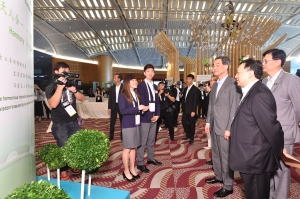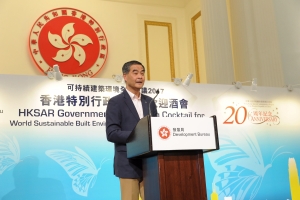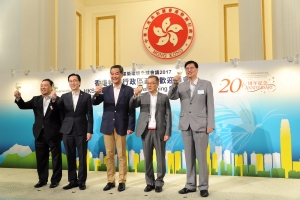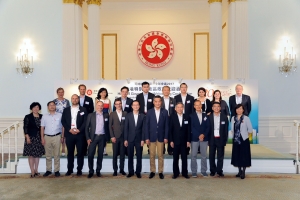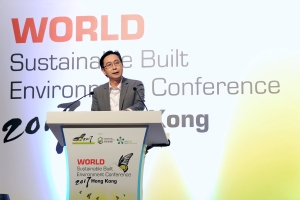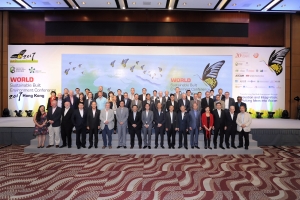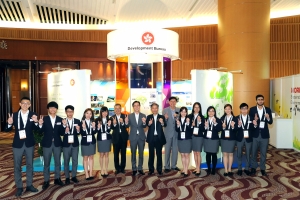“Harmonious Interaction Between Man and Nature” – World Sustainable Built Environment Conference
|
Hong Kong has been proactively contributing to China and the world in addressing the severe challenges posed by climate change. The well-prepared, much-anticipated World Sustainable Built Environment Conference , a major international event widely regarded as the Olympic Games of the green building industry, has just come to a successful conclusion. Hong Kong is honoured to host the conference this year, which brought together more than 1 000 government representatives, experts and academics in the green building industry from 57 countries or places for in-depth discussions and exchanges regarding the latest development and future challenges of sustainable building. Launched in 2000, the conference is in the seventh edition of its series this year. Thanks to the industry’s unfailing efforts, Hong Kong finally won the bid to host the conference. I am very pleased to learn that, with three years of preparation work by the Government and the industry, participants from around the world are much contented with the outcome of the conference. This year also marks the 20th anniversary of Hong Kong’s return to the motherland. While various sectors of the community celebrate this important occasion together, it has special meaning for us to explore with the world the ways to strengthen our co-operation on the major issue of sustainable built environment and address the severe challenges posed by climate change. At the conference, not only representatives from Hong Kong shared our unique compact and efficient development experiences, many authoritative figures around the world also gave perceptive insights into sustainable built environment. Among them were the Vice-Chair of the Global Covenant of Mayors for Climate and Energy and the former Executive Secretary of the United Nations Framework Convention on Climate Change, Ms Christiana Figueres; Professor Raymond Cole from the University of British Columbia in Canada; and the Director-General of the Department of Science and Technology and Energy Saving on Buildings, Ministry of Housing and Urban-Rural Development of China, Mr Su Yunshan. It is all the more meaningful to us as this may be the farewell presentation by Professor Cole before his retirement. I have learned a lot from his presentation on “Reframing Environmentalism: Shaping a Positive Future”. He opined that buildings should be regarded as catalysts for positive change, adding value and enabling the full potential of the social and ecological systems. He also believed that this would support the creation of a thriving and abundant world, which is contrary to popular perceptions that building works and environmental protection are mutually exclusive. His speech reminded me of exercising and applying the Chinese traditional wisdom of “harmonious interaction between man and nature” in the sustainable development. Harmonious interaction between man and nature A small number of people in the community often have misconception that development will inevitably damage the environment. In fact, these two aspects may not necessarily be incompatible. The key is to strike a balance between the needs of development and the environment, and preserve the ecological habitats and biodiversity during the process, so as to attain the ultimate goal of sustainable development. China is the cradle of human wisdom and civilisation. The concept of sustainable development can be traced back to ancient times, when people adhered to the philosophy of “harmonious interaction between man and nature”, realising that life and development should follow the rules of nature so as to attain harmony with the environment. For example, ancient Chinese buildings put great emphasis on location and orientation, hence the concepts of “facing the sea with the mountain behind” and “orientating in the north and facing the south”. In addition, buildings were generally constructed of local materials, highlighting the integration of buildings into the surroundings. Many other traditional architectural features, such as light wells and courtyards, made use of the natural environment to meet the needs of daylight provision, water catchment and ventilation. The philosophy emphasised the harmonious interaction between man and nature, which was also the theme of the Development Bureau (DEVB)’s exhibition at the Conference and showcased the grand wisdom of traditional Chinese architecture. Work together to achieve long-term vision The first day of the conference coincided with the World Environment Day of the United Nations. Countries around the world called on the public to face squarely the challenge of climate change and work together to cope with temperature rise and extreme weather. Climate change is an imminent issue and strengthening international co-operation is the global trend. No country can afford to stay out of it. Ms Figures, an active promoter of the Paris Agreement back then, said at the conference that reduction of carbon emissions was the global trend. Although the United States was an economic powerhouse, its economic development as driven by local governments and private enterprises was, to a large extent, steering towards the direction of low carbon emissions. That direction would not be affected by the decision of Mr Donald Trump, President of the US, to pull out of the Paris Agreement. Various countries and sectors, rather than being discouraged, are paying more attention to climate change, uniting their efforts and facing the challenge in a more proactive manner. She also opined that Asia is the barometer of urban landscape changes and Asian cities, such as Hong Kong, have great impact on the sustainable development projects around the world. She pointed out that despite the use of many green building features in some of the buildings in Hong Kong, there is still much room to promote the green building movement to be the mainstream of the industry. In fact, the Hong Kong Special Administrative Region (HKSAR) Government is determined to build Hong Kong into a liveable, competitive and sustainable “Asia’s World City”. This is also the vision of the long-term planning blueprint “Hong Kong 2030+” that we launched at the end of last year with policies focusing on reduction of carbon emissions. We always lead by example through the adoption of green building designs in government building projects that utilise energy-saving and renewable energy features. At the same time, the private sector is encouraged, through economic incentives, technical guidelines and regulations, to apply more green building designs to their projects. Two years ago, we set a target of reducing energy intensity by 40 per cent by 2025. Later, we formulated the “Hong Kong’s Climate Action Plan 2030+” in response to the Paris Agreement, aiming to reduce carbon intensity from the 2005 level by 65 to 70 per cent by 2030. As for transportation, currently, about 90 per cent of Hong Kong’s daily passenger trips are made by public transport, which is considered a high ratio by international standards. Given that rail transport is the most efficient means of transport in reducing carbon emissions, we are developing a transportation system centred on public transport, with railway as the backbone. At the same time, various projects are being launched to enhance the walking environment to encourage walking, promote a “bicycle-friendly” environment in new towns and new development areas and adopt smart and innovative measures so as to reduce emissions from motor vehicles. On one occasion during the conference, Ms Figures encouraged Hong Kong to realise its potential to become a leading smart, liveable city. Her thoughts are in line with the concepts behind our smart city initiatives. We aim to build a smart, low-carbon, sustainable and liveable community through technology-aided green planning, including the use of town planning or land sale conditions, the district cooling system, smart water meters and electric vehicle charging facilities. We will use Kowloon East as a pilot area, with a view to extending the scheme to other new development areas so as to build Hong Kong into a low-carbon smart city. Pass on the torch through youth participation The various initiatives mentioned above aim at pursuing sustainable development for our society in future. As young people are masters of our future society, we had gathered a group of youth ambassadors during the conference to brief overseas guests and conference participants on Hong Kong’s latest long-term planning and development as well as the DEVB’s work on green building promotion. The first-hand involvement and experience in major international events and public affairs can help young people enrich their lives and cultivate a sense of mission in sustainable development and combating climate change, which will in turn keep driving the green building movement forward. To quote the Chairman of the Organising Committee of the World Sustainable Built Environment Conference, Mr Wong Tin-cheung, Conrad, the world nowadays is borrowed from the next generation, and we must take good care of the natural environment so that we can return it intact to our next generation in future. Look forward to scaling new heights At the closing ceremony, I witnessed the successful bid by Sweden for the next World Sustainable Built Environment Conference to be held in Gothenburg in 2020. I look forward to continued co-operation among various countries in driving the green building movement, and hope that Sweden will follow our track to proactively motivate the young people and lead the next conference to scale new heights. Sharing of video clips:
The HKSAR Government welcoming cocktail for the World Sustainable Built Environment Conference
The DEVB’s youth ambassadors @ the World Sustainable Built Environment Conference
The closing ceremony of the World Sustainable Built Environment Conference |
|
11 June, 2017
Back